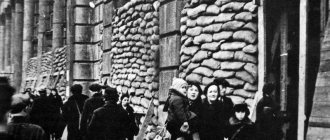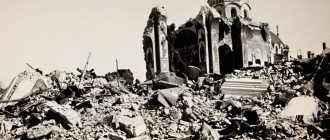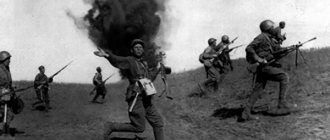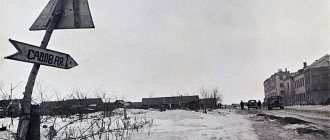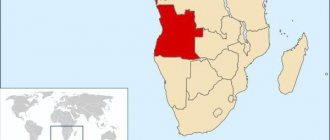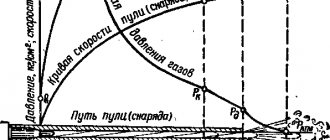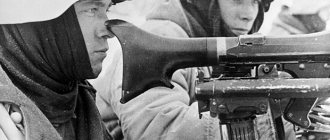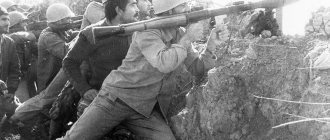Memorial dedicated to the siege of Leningrad
Leningrad, the second most important city of the USSR, during the Great Patriotic War became the site of a long-term and extremely stubborn battle, which influenced the entire course of hostilities. Leningraders and Soviet soldiers-defenders of the city had to act in extremely difficult conditions of complete blockade, with the opportunity to rely only on their own strength and resources.
The Leningrad blockade, which lasted from September 1941 to January 1944, became a significant page in the history of the city and country. Leningraders were able, through stubborn defense, to save the city from complete destruction, which threatened it in the event of a fall.
Historical background and position of the city
Founded as a new capital, St. Petersburg played this role until the end of the Russian Empire. Despite its proximity to the border, wars bypassed it. Revolutions, changes in the political system, and the return of the country's center of government to Moscow were reflected in the renaming of the city on the Neva to Petrograd, then to Leningrad, but its status as the most important political, industrial, scientific, cultural and transport center was preserved.
By the end of the 1930s, the “northern capital” had more than 3 million inhabitants, and the enterprises located here were a significant component of the military-industrial potential of the USSR. But the presence of the state border only 30-35 kilometers from Leningrad posed a security problem of strategic importance.
Attempts to ensure the transfer of the Soviet-Finnish border further from the city through negotiations were quite active, but did not bring success. As a result of the military conflict with Finland in 1939-1940, despite the difficulties of the initial stage, the USSR achieved the required transfer of the border, and to a greater distance.
The “Finnish War” had a noticeable impact on the life of Leningrad and its population, who were the first in the Soviet Union to experience all the vicissitudes of the status of a “front-line city.” There were shortages of transport used to support combat operations, interruptions in fuel and food supplies, but they were overcome and provided the necessary experience to many city leaders. And even partial military mobilization measures (blackout, transfer of some schools to military hospitals) made Leningraders more prepared for the coming big war.
After the Soviet-Finnish War, the headquarters of three armies (7th, 14th and 23rd) remained within the Leningrad Military District. But their numerical strength and striking power, based on modern military equipment, had already been significantly reduced by that time in favor of the western border districts. The command of the Red Banner Baltic Fleet (the largest in the USSR Navy) was also located in Leningrad. The fleet had impressive aviation and air defense forces.
Monuments on the Road of Life
In order to preserve in the memory of subsequent generations the feat of the defenders of Leningrad, monuments were erected on the Road of Life. A total of 7 monuments were installed:
- Flower of Life;
- Katyusha;
- Broken ring;
- Crossing;
- Diary of Tanya Savicheva;
- One and a half truck;
- Rumbolovskaya mountain.
In addition to them, 102 memorial pillars and memorial steles were installed along the highway and railway. Some of the steles are included in the complex of monuments and memorials, and some are installed separately.
Among the memorial buildings on the Road of Life, the monument to the “lorry” stands out. There is simply nothing like him anymore. “Lorry” was popularly called a car with a carrying capacity of one and a half tons. It was on such trucks that people and goods were transported along the Road of Life. In the place of the road where the most massive shelling took place, today there stands a life-size truck cast in bronze.
Monument "Lorry" on the "Road of Life"
Flower of Life
The road of life passed not far from Vsevolozhsk. There, on the third kilometer of the memorial route, the Flower of Life complex was opened in 1968. It is dedicated to the youngest victims of the siege of Leningrad. After all, during the years of the siege, children became not only passive victims of hunger and shelling. To the best of their ability, they helped in the defense of the city, taking on responsibilities that would otherwise be entrusted only to adults. Schoolchildren extinguished incendiary bombs, stood on patrol, helped in hospitals and collected raw materials for military needs.
The memorial complex consists of three parts. First, the visitor is presented with a 15-meter sculpture of a flower, on the petals of which are carved the words of a children’s song popular in the USSR: “Let there always be sunshine” and an image of a pioneer boy. Next comes the Alley of Friendship, which consists of nine hundred birches - according to the number of days of the siege. Scarlet pioneer ties are tied to tree trunks in memory of the dead children. Behind the alley is a funeral mound. Rarely is there any mention in guidebooks about the Road of Life without a photo of this mound. Among other attractions, there is a diary of a girl, recreated in stone, who, in an incorrect childish handwriting, successively wrote down the dates of death of her family members in a notebook.
Monument "Flower of Life" on the "Road of Life"
Broken ring
On the western shore of Lake Ladoga, where the Road of Life began, there is another monument. With stern brevity, it symbolically illustrates interesting facts about the Road. Two massive semi-arches, in the shape of a torn ring, seven meters high, remind of the blockade ring. And the rupture of the memorial itself, the Broken Ring, points to the Road of Life. Under the ring towards the descent to the lake, right along the stonework, there is a concrete track from the wheels of a car.
From here, during the years of the blockade, trucks began their journey, delivering valuable cargo of food and ammunition to the besieged city. Beneath the impressive monument are the words from a poem by Bronisław Kezhun:
“Descendant, know: in harsh years,
Loyal to the people, duty and Fatherland,
Through the ice hummocks of Ladoga
From here we led the road of Life,
So that life never dies."
Monument “Broken Ring” on the “Road of Life”
Osinovetsky lighthouse
The road of life is most often associated with trucks on ice and snowstorms. However, when the ice melted, it did not stop functioning. It’s just that in warmer times the Ladoga flotilla took on the load. Often it was even more difficult and dangerous than moving on ice in cars. The coastline of Lake Ladoga has never been conducive to shipping.
In late spring, summer and early autumn, ships plying on the lake were guided by the light of the Osinovetsky lighthouse, located on the southwestern shore. This lighthouse is still in operation today. There are no excursions there, since the lighthouse is a strategic site and is under the jurisdiction of the Ministry of Defense.
Construction of the Osinovetsky lighthouse began back in 1905. Since then he has not stopped his work. The light of the lighthouse indicates the western border of the bay, from which the Neva begins its journey. It rises 74 meters above the lake level, and the light of the lighthouse is visible at a distance of 40 kilometers.
Monument "Osinovetsky Lighthouse" on the "Road of Life"
Due to the fact that during the blockade the Osinovetsky lighthouse served as an important landmark for ships traveling along the Road of Life, it is classified as a cultural heritage site, although it is not a monument as such.
Katyusha
The road of life was the only connecting thread between besieged Leningrad and the rest of the country. The only artery through which food and ammunition arrived. She was what kept the city alive. The defenders of Leningrad understood this very well, the Leningraders themselves understood this, and the Germans understood this. They desperately tried to cut off this last line of communication in order to finally strangle resistance and destroy the weakened city.
The road of life was under constant fire. To protect against enemy aircraft, it used the legendary Katyusha launchers. In memory of this, on the site where anti-aircraft units were located during the war, a monument was erected, reminiscent of these defensive guns that covered the movement of trucks. It consists of steel beams directed into the sky, each of which is 14 meters long. There are 5 such beams in total. They represent the famous "Katyusha".
Monument "Katyusha" on the "Road of Life"
Beginning of the war (June-September 1941)
The German Barbarossa plan, developed for the war with the Soviet Union, directly pointed to Leningrad as one of the three main directions of attack. Army Group North was to operate in this direction under the command of Field Marshal W. von Leeb. From the beginning of the war, it included the 16th and 18th Armies, the 4th Tank Group, and the 1st Air Fleet was sent to support these forces.
As a result of the border battle, Army Group North managed to cut the Soviet North-Western Front in two and take Pskov on July 9. The Soviet leadership, realizing the immediate threat to Leningrad, from the beginning of July directed forces to build fortified lines on the borders around the city, the total length of which was about 900 kilometers. On July 10, the Main Command of the North-Western Direction was formed, headed by Marshal K. E. Voroshilov.
Construction of the Luga defensive line
The Red Army, relying on the Luga defensive line, was able to delay the German offensive for almost a month. This was greatly facilitated by a successful counterattack in the area of the city of Soltsy, where it was possible to inflict significant losses on the mechanized strike forces of the Wehrmacht.
The time gained made it possible to form reserves in the form of two new armies (42nd and 55th) to protect the approaches to Leningrad. In addition, the process of evacuating part of the enterprises and population was launched, covering almost half a million Leningraders. But after a pause to replace losses, the Germans were able to break through the Soviet defenses and by the end of August reach the outskirts of Leningrad. On August 29, the Germans captured the Mga station and cut the main railway line.
After the bombing of cities and military bases in Finland by Soviet aircraft on June 25, that country declared war on the Soviet Union. The Finnish army began active offensive operations on the Karelian Isthmus on July 31 and was able to achieve success within a month, stopping at the line of the old Soviet Karelian fortified area.
The road of life. Map
Sections of ice roads were calculated and laid based on data from divers and scientists from the Hydrological Institute. On the operational military map, the Road of Life constantly changed its outlines. Often the reason was that the delivery of goods took place in areas that, due to bombing, became dangerous. And the weather constantly made its own adjustments. Temperature changes, underwater currents and other external factors greatly influenced sometimes the entire route, and sometimes only a separate section of the route. Traffic on the ice tracks was corrected by traffic controllers. During the first winter alone, the ice road was completely moved 4 times. And some areas changed their configuration 12 times.
It is with such changes that the difference in data on the length of the path in historical documents is associated. In addition, the map of military highway No. 101 also included a land section to the railway station. Some indicated the full mileage, and some indicated only the section that was called the “Road of Life” on the ice of Lake Ladoga.
The road of life. Map
Beginning of the blockade (September-December 1941)
Already in mid-July, the Wehrmacht command ruled out the assault on Leningrad as a possible task, relying on the complete encirclement of the city. According to Hitler's directive number 35 of September 6, the 4th Panzer Group, used to break through to the Soviet “northern capital,” had to be urgently redeployed for the attack on Moscow. After the capture of Shlisselburg by German troops on September 8, land communications between Leningrad and the rest of the country were interrupted.
The troops of Army Group North tried to carry out the order to completely encircle the city, but the stubborn defense of the Red Army units did not allow this to happen. The dominant Pulkovo Heights remained under the control of Soviet troops. The Wehrmacht's few successes included the capture of Krasnogvardeisk, Pushkin and Krasnoe Selo, as well as the dissection of Soviet defenses in the Peterhof area, where an isolated Oranienbaum bridgehead was formed.
The formation of a blockade ring pushed the Soviet command to hasty and uncoordinated actions within the framework of the Sinyavinsk operation. The resulting siege was supposed to be lifted by the forces of a separate 54th Army under the command of Marshal G.I. Kulik. This offensive met with strong opposition from the Germans and ultimately was only able to advance 5-10 kilometers.
At the same time, the entire top Soviet military leadership mistakenly expected the Wehrmacht to storm the “city of Lenin.” Army General G.K. Zhukov, who replaced Voroshilov at the head of the troops of the Leningrad Front on September 13, took a number of active measures to form and transfer units, including the replenishment of ground units with Baltic Fleet sailors. As a result, Zhukov actually scattered his forces, forcing subordinate commanders of formations to conduct constant counterattacks in directions of secondary importance, often already fortified by the Germans.
During this period, an important operation of the Soviet troops took place to capture a small bridgehead in the Nevskaya Dubrovka area, called the “Nevsky patch”. Attempts to develop an offensive from here with the aim of eliminating the Shlisselburg salient and further breaking the blockade were unsuccessful and led to significant losses.
Map of the situation near Leningrad at the end of 1941
German troops, having gained a foothold in the suburbs at a distance of 4-7 kilometers from the city limits, switched to active artillery shelling and aerial bombardment of Leningrad. The top of the “Third Reich” openly admitted their desire to completely destroy the “city of Lenin”, while relying on the destruction of residential buildings by artillery and the quick death of those besieged from hunger.
From the very first days of the blockade in Leningrad, the problem of organizing food supplies became acute. The available reserves could last for a maximum of a month, which forced the city leadership to significantly reduce their consumption standards starting in October. Supply by air and water via Ladoga only partially solved the problem, but soon this route was also put at risk.
Army Group North was able to capture Tikhvin and Volkhov by the beginning of November, threatening access to the Svir River, at the border of which Finnish troops were stopped. The formation of enemy troops east of Leningrad threatened the city with inevitable death. The North-Western Front managed to first stop the Germans, and by the beginning of December - to return the previously lost cities and the railway to the coast of Lake Ladoga.
Food supplies in besieged Leningrad were quickly melting, and from November 20 to December 25, 1941, food distribution standards reached the minimum amount for the entire period of the siege. For employees, dependents and children, this norm was 125 grams of bread per day, for working citizens - 250 grams. Only towards the end of 1941 was it possible, by increasing the ice cover of Lake Ladoga, to establish transport communications with the blockaded city.
125 grams of bread: the minimum daily food requirement for a siege survivor
Next stop - the front
Many have heard the story of the Marne taxi: in September 1914, Joseph Simon Gallieni, the military commandant of Paris, mobilized civilian vehicles, including taxis, to transport troops to the front, which was very close to the city. Subsequently, the story became something of a calling card for French taxi drivers who contributed to the defense of Paris.
German soldiers in the trenches near Leningrad
Meanwhile, in Leningrad by September 1941, a much more difficult situation had developed. There was no talk of a couple of tens of kilometers, like to the Marne. The Germans practically entered the city and gained a foothold in Pushkin, Pavlovsk and Peterhof. In the southeast of Leningrad, where the Rybatskoye and Obukhovo metro stations are now located, the Germans came close to urban development.
Those who carefully read “Two Captains” probably remember how Katya Tatarinova went to the front by tram.
“You could get to the front by tram; Petina’s division was now stationed in Slavyansk. He asked not to accompany him - it was risky, in Rybatsky without a pass I could be detained. But I went."
Moreover, other tram routes had already been cut by the Germans. The unique ORANEL line (Oranienbaum Electric Line), built shortly before the First World War, was divided when Strelna was captured by the Germans in the fall of 1941. KV tanks, produced at the Kirov plant, located in the south of Leningrad, practically left the gates for the front. It cannot be said that the enemy was at the gates of the city: he had already entered the city.
Breaking the siege of Leningrad in 1943
The 1943 operation to break the blockade of Leningrad was called “Iskra” (and this name was personally proposed by J.V. Stalin). To achieve the goal, in the same area where Soviet troops had suffered failures many times already, forces and means were concentrated to ensure fivefold superiority over the enemy. The operation began on January 12, and six days later the Leningrad and Volkhov fronts united, breaking through the Leningrad blockade ring.
Breaking the blockade of Leningrad
It took a little more than two weeks to put rail and road communications into operation in the land corridor that had been broken through to Leningrad. This new supply route for the city, still under siege, was called the “Victory Road.” The second blockade winter passed in fairly acceptable conditions of food supply to the “city of Lenin”.
In February-April 1943, Soviet troops near Leningrad tried to build on their success and defeat the German Army Group North, but failed. As part of the German troops, defensive actions were carried out, in particular, by the Spanish “Blue Division”, formed on a volunteer basis (due to the official neutrality of Spain in World War II). This unit held positions on the Izhora River and was able to successfully repel attacks by units of the Soviet 55th Army. In November 1943, the division was recalled to its homeland.
How they paved the Road of Life
From the very beginning it was clear that the shipping route was a temporary measure. The cold weather was soon to come. Therefore, ahead of time, employees of the Hydrological Institute and the road department of the Leningrad Front began to design a highway that was to be laid directly on the ice of frozen Lake Ladoga.
In the documents it was called military highway No. 101. There were to be heating points at every fifth kilometer of the route. And they planned to make the road itself 10 meters wide. But in reality everything was much more complicated than on paper. Given that the Road of Life, as the Leningraders themselves called it, passed through places of the shallowest depths, the ice often broke through, taking not only valuable cargo, but also many human lives.
Military highway No. 101
The length through Ladoga was approximately 30 kilometers. Tens of thousands of people worked harmoniously on this relatively small site in difficult conditions. These were truck drivers and horse-drawn drivers, mechanics who repaired cars, traffic controllers whose task was to direct drivers along the safest routes. In addition, there were those who directly paved the road. And it had to be laid constantly. At times because the road was covered with snow, at times because it was necessary to choose areas with a stronger layer of ice, and at times because the road was damaged by German air raids, which were carried out with enviable regularity.
The road of life was constantly being repaired. Divers strengthened it with all possible means at hand, diving under the ice and installing flooring and supports there. This was far from just a wide track laid on ice. Road signs were installed along the road. Along the route of the trucks, medical and heating stations were built. Along the route there were warehouses and bases. Technical assistance stations, workshops and food stations were also equipped. Telephone and telegraph communications passed along the road.
Lifting the blockade of Leningrad
The operation to completely release the blockade began on January 14, 1944 with joint attacks by the Leningrad and Volkhov fronts on the flanks of the German defense in the areas of Peterhof and Novgorod. The enemy's defensive line was broken through, but a significant part of the Wehrmacht forces, abandoning heavy weapons, was able to escape from the encirclement prepared for them.
On January 21, the Germans began withdrawing their troops from the Mginsko-Sinayavinsky ledge to new defensive lines near Narva and Luga. Soviet troops, through stubborn battles, were able to seriously disrupt these plans, and after the capture of Krasnogvardeysk, achieve the division of the 18th German Army into two parts. As a result of this offensive, German troops were driven back from the city, and on January 27, a special order was issued along the front, announcing the final lifting of the blockade of Leningrad.
The further development of this offensive pushed the Soviet-German front line away from the “northern capital” by more than 200 kilometers. In mid-June, Soviet units pushed back Finnish troops holding the Karelian Isthmus more than 100 kilometers to the north. At the same time, several well-fortified enemy defensive lines were consistently broken through.
Ice reconnaissance
The unusually severe frosts that struck in November 1941 played a dual role in the fate of Leningrad. On the one hand, the city, left on a starvation ration of fuel, began to rapidly freeze, which sharply increased mortality: hungry people did not resist the cold well. On the other hand, early cold weather also caused early freeze-up on Ladoga, which made it possible to build the “Road of Life” earlier than planned. Already on November 12, the first scouts from among the hydrographers of the Baltic Fleet entered the thin Ladoga ice, who, under the leadership of Mikhail Kazansky, began researching the speed and nature of freezing of the ice cover on the southern shore of the lake, where the distance between the Leningrad shore and the mainland was the smallest. And the very next day, November 13, the head of the logistics service of the Leningrad Front, Major General Feofan Logunov, signed an order “On organizing the construction of an ice road along the water route Cape Osinovets - Kareji Lighthouse.” This document recorded the extreme points of the future “Road of Life”: the Osinovetsky lighthouse was located on the Leningrad side, and the Kareji lighthouse was located on the southeastern shore of Ladoga.
A truck that partially fell through the ice on the “Road of Life”
Source: livejournal.com
On November 15, 1941, the main stage of reconnaissance of the trajectory of the future route of the ice road began: together with military hydrographs, it was carried out by soldiers of the 88th separate bridge-building battalion. A total of 12 reconnaissance groups, moving from Osinovets and Kokkorevo (a village on the southwestern shore of Ladoga), walked to the eastern shore and became convinced that it would not be possible to lay the route as originally planned. Despite the fact that it was originally supposed to pass through the shallow part of the lake, which freezes faster and harder, the original route through the island of Careggi, located further north, turned out to be impossible: there was still open water there. But further south, in the area of the Zelentsy Islands, the ice turned out to be strong enough to try to run at least a sleigh train across it. It was not yet possible to start the trucks: an attempt to deliver the first fifty bags of flour to Leningrad, undertaken from the village of Kobona, which became the starting point of the future “Road of Life” from the east, ended in failure: 20 km from the coast, the lorry stumbled upon a huge wormwood and was forced to turn back.
The results of ice reconnaissance were reported to the headquarters of the Leningrad Front on the morning of November 19. And soon the front commander, Lieutenant General Mikhail Khozin, issued an order to organize a road and tractor road across Lake Ladoga. On the same day, a sleigh train of 350 teams set off from Kokkorevo towards Kobona, which returned two days later, delivering 63 tons of flour. This was the first cargo to arrive in Leningrad along the “Road of Life”.
Traffic controller at the intersection of the “Road of Life” from the mainland, 1942
Source: waralbum.ru
How many days did the blockade last?
The phrase about the “900-day blockade” that appears repeatedly in various sources is nothing more than a literary image that was caused by the desire to “round off” a significant figure. According to historians about how many days the siege of Leningrad lasted, this figure is 872 days. The main milestone dates are:
- 09.1941 - the beginning of the blockade, cutting off the city from all land communications;
- 01.1943 - the formation of troops of the Leningrad and Volkhov fronts, which broke through the blockade ring;
- 01.1944 - final lifting of the blockade of Leningrad.
The differences in the concepts of “impulse” and “lifting” of the blockade are due to the factor of control over transport communications of Leningrad. Breaking the blockade did not change their temporary nature, therefore the restoration of Soviet control over the October Railway was recognized as the lifting of the blockade.
In general, the concept of the defense of Leningrad has a broader time frame: from July 10, 1941 to August 9, 1944, until the final liberation of the territory of the Leningrad region from the occupiers. The Battle of Leningrad is considered one of the longest battles of World War II.
Monument to those killed during the siege at Piskarevskoye cemetery
The road of life through Lake Ladoga
When the blockade ring closed, the only possibility of communication with besieged Leningrad remained - through Lake Ladoga, the coast of which continued to be controlled by the Soviet army during the Great Patriotic War. This lake was very difficult for navigation. Unexpected gusts of wind often hit ships. Therefore, the coast was not equipped with either berths or piers.
The first cargoes delivered were dumped directly on the wild coast. At the same time, work was urgently carried out to deepen the bottom and develop the harbor. Dugouts were dug on the shore and warehouses were equipped. Telephone and telegraph cables were laid underwater. A narrow-gauge railway was built from the shore to the nearest railway line.
A traffic controller at the entrance to the icy “Road of Life” near the village of Kokkorevo.
Already on September 12, just four days after the start of the siege of Leningrad, the first batch of cargo was delivered across Lake Ladoga. There were 60 tons of various ammunition and 800 tons of food. Leningraders were taken on the return flight. During the autumn navigation, until the ice made it impossible to move around the lake, 33.5 thousand people were evacuated from the city by water. During the same time, 60 thousand tons of cargo were delivered to Leningrad.
In addition to unfavorable weather conditions, transportation was complicated by constant German air raids. The use of available tugs and barges for delivery was strongly encouraged. However, even the full load of all the ships could not fully provide food to the surrounded city. In addition, the task was further complicated by the fact that it was not only food that had to be supplied. To wage war and defend the city, weapons were required. Therefore, part of the cargo consisted of ammunition.
